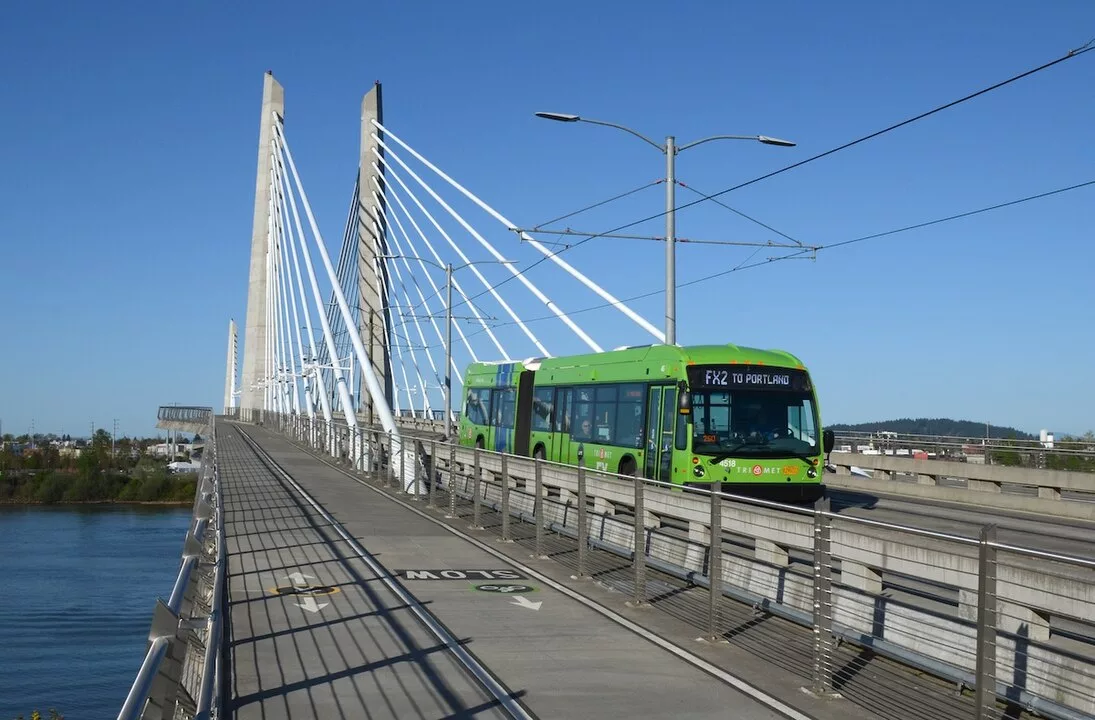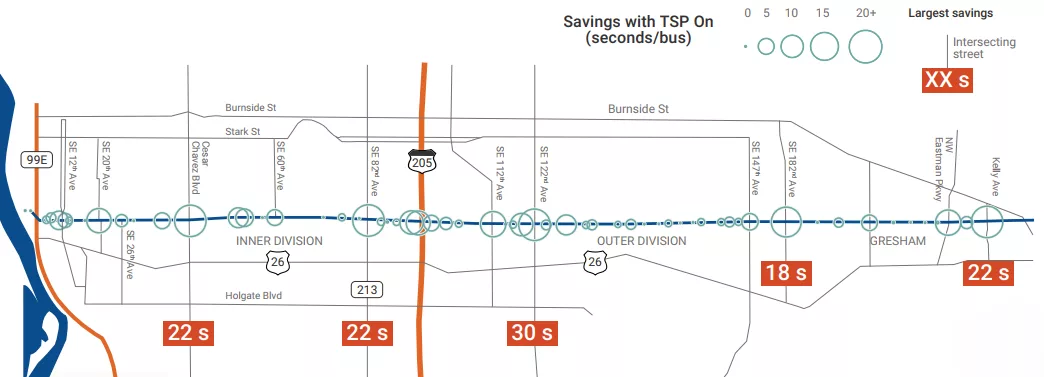
This post is based on a paper published on Transportation Research Record I-16 by Cesme, Barrios, Koonce, Haines, Furth, Bame, and Dobrota (2025). https://doi.org/10.1177/03611981251337467
The Promise (and Pitfalls) of Transit Signal Priority
Planners and engineers have long recognized Transit Signal Priority (TSP) as a key strategy to make transit faster and more reliable, ultimately making it more efficient and attractive to travelers. TSP is really a collection of signal timing techniques designed to give priority to transit vehicles by adjusting traffic signal operations.
However, traditional TSP deployments in the U.S. have often yielded only marginal improvements, with typical delay reductions of less than 3 seconds per intersection. The reasons for these limited benefits are multifaceted:
- Conditioning priority to late buses: Most systems employ conditional TSP, only granting priority if a bus is significantly late (e.g., 5 minutes behind schedule). Although this can help reliability, it does not result in a consistent reduction in travel times.
- Limiting TSP within peak hours: Some systems deactivate TSP during peak hours, presumably to limit impact to motorists when traffic is near capacity.
- Restrictive lock-outs: “Lock-out” policies inhibit TSP for a specified duration (e.g., 2 minutes) or number of cycles after a priority event, intended to allow vehicular traffic to recover.
- Inaccurate predictions: Malfunctions or improperly placed TSP equipment can trigger activations at the wrong time. Also, many traditional TSP systems do not consider traffic congestion within the intersection, leading to poor predictions during peak hours.
How Portland’s Next-Generation TSP Works
TriMet, in collaboration with the Federal Highway Administration, the Oregon Department of Transportation, and the City of Portland, partnered with LYT.transit, a next-gen TSP vendor, to deploy state-of-the-practice TSP on the Division Street FX2, its inaugural high-capacity bus line.
LYT’s system is a data-driven, cloud-based, and asset-light version of traditional TSP. By focusing on generating better and more timely predictions of bus arrivals at the traffic signals, next-gen TSP expands the options available to traffic signal engineers. This flexibility has the dual benefit of reducing delay for buses while spreading out the adjustments so that other modes are not impacted as much. Below is a general comparison of next-gen TSP against the traditional version.
| Characteristic | Traditional TSP | Next-Gen TSP |
|---|---|---|
| TSP configuration | Static, at installation | Cloud-based, continuously updatable |
| Hardware needed | Dedicated devices on vehicles and signals | Centralized server |
| Data needed | None (detection-based) | – Real-time AVL – Historical AVL |
| Detection (prediction) horizon | <10 seconds | 120+ seconds |
| Prioritizes | Late-running transit vehicles | All transit vehicles |
| Capital cost | $$$$ | $ |
| O&M cost | $$ | $$ |
These are typical settings for traditional and next-gen TSP, but they vary
The Secret Sauce Behind Portland’s TSP Success
Next-generation Transit Signal Priority (TSP) offers numerous advantages over traditional TSP, but the success of Division Street’s TSP implementation extends beyond just the technology. A significant contributing factor is the long-standing collaboration between TriMet and the Portland Bureau of Transportation (PBOT). These organizations have a history of working together on signal timing for MAX and streetcar lines, while also prioritizing a high level of service for bicyclists and pedestrians.
This institutional knowledge and technical expertise empowered PBOT engineers to fully leverage the capabilities of next-generation TSP. They were able to customize the signal controller logic for each intersection, using their deep understanding of the user needs. These thoughtful adjustments resulted in observably faster bus travel times compared to the “plain” next-gen TSP, all while minimizing impact on other intersection users.
Significant Running Time Savings & Cost Benefits
The Portland example is not just notable because of its technology, but also from a transportation research perspective. TriMet and PBOT were fully committed to understanding the impacts of this new system—so much so that they actually turned off TSP for a week to generate data for a clean comparison.
TriMet used several strategies to speed up bus travel on Division Street, including near-level boarding, all-door boarding, semi-dedicated lanes, fewer stops, queue jumps, and TSP. Having TriMet turn off TSP for a week was critical in isolating the impact of next-gen TSP.
As soon as the data came in, it was clear that TSP had been making a big difference. Following a rigorous quality review and analysis of the data, it turned out that TSP cut delays at major intersections by an average of 69%. Smaller intersections saw much smaller reductions, as the delays to buses on Division Street were already low at those intersections. Across all intersections with TSP, bus delays were down 45%.

The faster and more reliable rides are great for TriMet’s riders, but what is the economic benefit to the transit agency? TriMet’s NTD report says that operating a bus for an hour costs them $143. TSP was found to reduce the runtime by 7 percent across the whole route, even as segments with TSP saw a bigger reduction. The 7 percent reduction meant 13 bus-hours saved per day, or about $2,000 in operating expenses. Over a five-year period, the savings to TriMet would exceed $3M. And that is just on a portion of one bus route… with potential to expand to other routes at little additional cost.
Key Takeaways and Future Implications
- Next-gen TSP is very cost effective. Compared with hardware-heavy solutions—and certainly compared to capital projects—next-gen TSP provides important benefits at a relatively low cost.
- Do your homework first. Next-gen TSP has a low marginal cost of deployment (i.e., once it’s set up, adding more locations isn’t that expensive). However, you can achieve a large majority of the benefits by identifying and focusing on your biggest sources of delay, which are typically major intersections.
- Benefits of focus. By being more focused on fewer locations, you can do what Portland did and optimize for the unique challenges and opportunities at each of those locations, fine-tuning controller logic for better results.
- Buy-in leads to success. Technology was important, but only as a means to an end. Portland decided to prioritize transit and pedestrians on Division Street. That goal was key in implementing a system that delivered a better experience for transit and pedestrians, with basically negligible impacts on other modes.
Let’s speed up your buses
We are passionate about helping transit agencies and their riders get to where they need to go. Drop us a note to discuss whether next-gen TSP might be a good fit for your agency.
